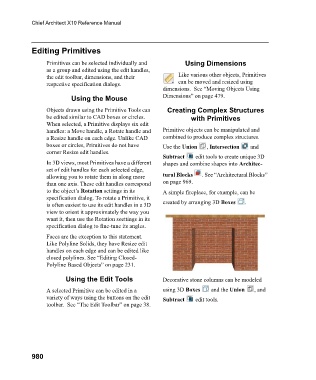Page 980 - Chief Architect Reference Manual
P. 980
Chief Architect X10 Reference Manual
Editing Primitives
Primitives can be selected individually and Using Dimensions
as a group and edited using the edit handles,
the edit toolbar, dimensions, and their Like various other objects, Primitives
respective specification dialogs. can be moved and resized using
dimensions. See “Moving Objects Using
Using the Mouse Dimensions” on page 479.
Objects drawn using the Primitive Tools can Creating Complex Structures
be edited similar to CAD boxes or circles. with Primitives
When selected, a Primitive displays six edit
handles: a Move handle, a Rotate handle and Primitive objects can be manipulated and
a Resize handle on each edge. Unlike CAD combined to produce complex structures.
boxes or circles, Primitives do not have Use the Union , Intersection and
corner Resize edit handles.
Subtract edit tools to create unique 3D
In 3D views, most Primitives have a different shapes and combine shapes into Architec-
set of edit handles for each selected edge,
allowing you to rotate them in along more tural Blocks . See “Architectural Blocks”
than one axis. These edit handles correspond on page 969.
to the object’s Rotation settings in its A simple fireplace, for example, can be
specification dialog. To rotate a Primitive, it
is often easiest to use its edit handles in a 3D created by arranging 3D Boxes .
view to orient it approximately the way you
want it, then use the Rotation seettings in its
specification dialog to fine-tune its angles.
Faces are the exception to this statement.
Like Polyline Solids, they have Resize edit
handles on each edge and can be edited like
closed polylines. See “Editing Closed-
Polyline Based Objects” on page 231.
Using the Edit Tools Decorative stone columns can be modeled
A selected Primitive can be edited in a using 3D Boxes and the Union , and
variety of ways using the buttons on the edit Subtract edit tools.
toolbar. See “The Edit Toolbar” on page 38.
980

